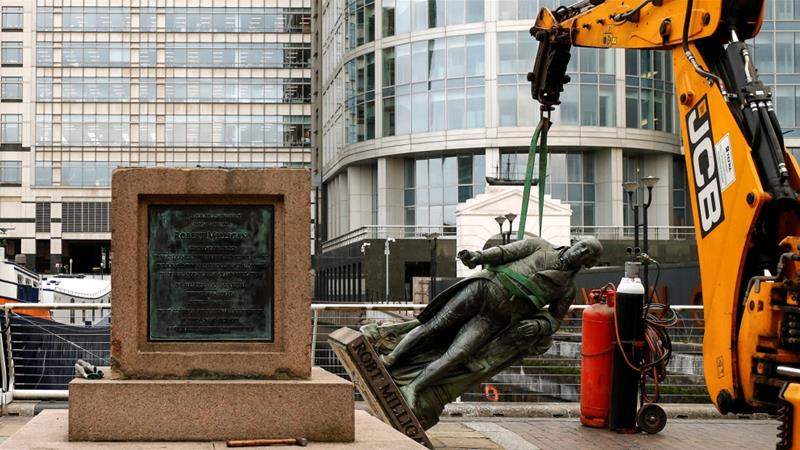Last weekend ’s demolition of the statue of slave trader Edward Colston in Bristol (the monument was later thrown into the waters of the English city’s harbor) has restarted a discussion about monuments in the United Kingdom, and dismantling of controversial statues has begun in some cities. Indeed, there are many monuments in the country that celebrate philanthropists who made their communities prosper but owed their fortunes to activities such as trading and the slave trade.
In London, the capital’s mayor, Sadiq Khan, has announced that a commission (the “Commission for Diversity in the Public Realm”) will be formed to enhance diversity in public spaces, focusing on ways to better represent ethnic minority communities, women, the LGBTQ+ community, and the disabled. Among the actions will be a review of monuments. The mayor has already let it be known that he has been in discussions with the city council, the community and industry stakeholders to understand how the legacy of the past should be celebrated, to draw up a list of recommendations to establish best practices and standards, and to reconsider the glorification of figures with controversial pasts.
“The capital’s diversity is our greatest strength,” Khan said, “but our statues, our odonomastics and our public spaces reflect a time that is gone. It is uncomfortable to know that our nation and our city owe much of their prosperity to their role in the slave trade, yet this is reflected in our public spaces, while the contribution that many communities have made to the life of our capital has been deliberately ignored. This cannot continue: we need to make sure that we celebrate the achievements and diversity of everyone in our city, and we need to commemorate those who made London what it is today, and that involves thinking about what legacies are being celebrated.”
Also addressing statues is Gaylene Gould, a member of the Mayor’s Cultural Leadership Board: “Statues are symbolic landmarks of our nation. Carved in stone, they become immovable and problematic objects because they cannot be challenged. In this new and imaginative period we have entered, it is time to create a new model for honoring in public the people of London and its many, many cultures. The new commission takes a step in the right direction.”
Meanwhile, in Docklands, the large neighborhood on the Thames River in the eastern part of the city, the dismantling of a statue of Robert Milligan (1746 - 1809), a slaveholder active in the late 18th century in India, has already been completed (the monument, made of bronze, was erected soon after his death in 1809). “We accept the wishes of the local community about the statue of Robert Milligan at Docklands,” the Canal & River Trust, the state body that protects canals and rivers in the UK and serves as the navigation authority for the Docklands water basin, wrote in a note, “and we are committed to working with the borough of Tower Hamlets, the Museum of London Docklands and partners at Canary Wharf to arrange for safe removal as soon as possible. The Trust supports communities living along the waterway against racism.”
The work was then promptly removed in recent hours. “The East End,” reiterated John Biggs, mayor of the Tower Hamlets constituency, “has a proud history of fighting injustice, but we must also face our past and learn from it to continue to fight against racism and intolerance today.”
Similar debates are being addressed in these hours in Oxford, where in the past few days thousands of protesters have called for the removal of the monument to Cecil Rhodes (1853 - 1902): the university city’s Labor councillors wrote a letter to the University of Oxford asking the university to “make Oxford a truly anti-racist city” by removing the statue of the colonialist politician from Oriel College. There are many other figures the Black Lives Matter movement would like to remove from the streets: in Tavistock and Plymouth, Devon, a petition calls for the removal of the statue of privateer Francis Drake (1540 - 1596), identified as a “pioneer” of the slave trade. The Irish, on the other hand, would like the removal of the statue of Oliver Cromwell in London, since the “Lord Protector” in Ireland behaved anything but well. Accusations and smearing (for now) do not spare even the monuments to Winston Churchill: his racist attitude is not forgiven.
Then there are those who have decided on a different approach: this is the case of the city of Edinburgh, which has the problem of the Melville Monument, one of the symbols of Scotland’s capital. It is the monument to Henry Dundas, first Viscount Melville (1742 - 1811), who has been the subject of some vandalism in recent days because of his obstructionism to the abolition of slavery. The city council of the city, which is administered by a coalition formed by Labour and Scottish Nationalists (who stand on the center-left), decided not to remove the statue, but to enhance the monument with a plaque that will explain who Melville was and what his connections to the slave trade were.
Pictured: the removal of Robert Milligan’s statue.
 |
| After end of Colston monument in Bristol, UK begins dismantling of controversial statues |
Warning: the translation into English of the original Italian article was created using automatic tools. We undertake to review all articles, but we do not guarantee the total absence of inaccuracies in the translation due to the program. You can find the original by clicking on the ITA button. If you find any mistake,please contact us.